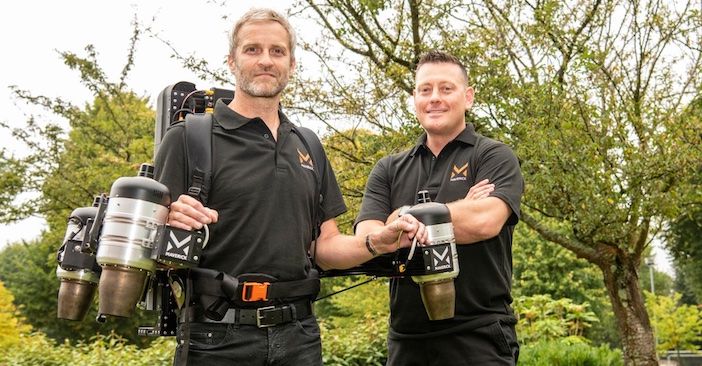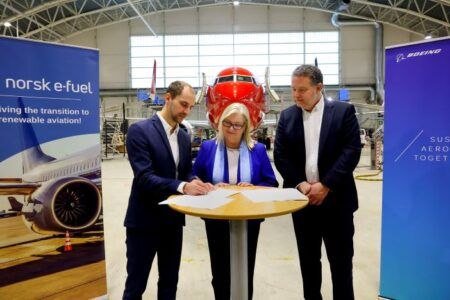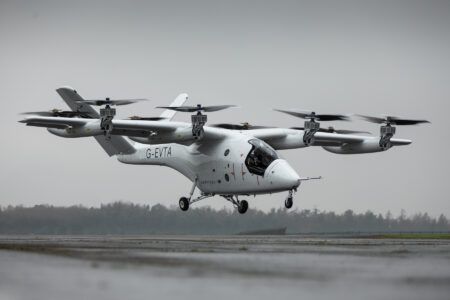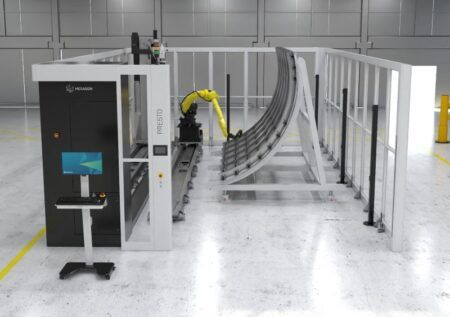A Southampton, UK-based startup have revealed the design of a prototype jetpack, which it
The Maverick Jetpack has been developed by Hollywood animatronics expert Matt Denton and Royal Navy Commander Antony Quinn.
Its first manned test flight is scheduled for next summer and the company is about to start seeking further investment to take the jetpack to market.
The jetpack is designed to be operated hands-free, allowing people to make safer flights, and precision landings on structures that are difficult to access — from wind turbines to military hardware, buildings and construction projects. The control system features the capability for the operator to switch on an in-built autopilot so they can multi-task while in flight if necessary.
The Jetpack is intended for use as a heavy-lift drone capable of being operated remotely. Maverick Aviation says it can carry a payload up to ten times that of similarly sized systems on the market.
The company estimates the potential market for security, defence and rescue uses alone is worth in excess of £700 million (US$970 million). It believes other uses include search and rescue, leisure, disaster relief, security and policing.
The jetpack has been made using 3D printing and with materials including aluminium, titanium and carbon fibre to minimize its weight. It will travel at between 10-30mph (16–48 km/h) depending on the task.
Maverick Aviation co-founder and chief technology officer Matt Denton career has included developing animatronics and control systems for Star Wars, Jurassic World and Harry Potter movies.
Antony Quinn, CEO and co-founder of Maverick Aviation said, “The jetpack uses the same sort of jet engines that you see on a passenger plane, only ours are the size of a rugby ball.
“Our computer-controlled autopilot system makes flying effortless and easy to control with precision. That’s how are changing jetpacks from exciting to useful.
“It’s so intuitive to fly that the cost of training is going to be low, so you’re going to have all sorts of professionals suddenly able to work in the most inaccessible environments safely and quickly.
“I realised that the growing onshore and offshore wind industry really needed a solution like this. Their engineers climb up ladders inside these structures for hours each day and, in an emergency situation, it’s almost impossible to get down quickly. Drones can be useful for inspections, but in many circumstances you need to get an engineer up there.
“During tours of Afghanistan and Iraq, the number of possible use cases just kept on mounting and I realised how big the opportunity was. The potential is almost endless.
“Before, people would have used a £30m helicopter to perform some simple tasks, we can offer a more tailored solution at a fraction of the cost.”
Early work on the control system software was funded by a £97,000 grant from Innovate UK, secured by Maverick’s grant partner Catax. This money also helped pay for patent applications and the creation of a concept demonstrator.
Karen Taylor, Group Head of Grants said, “What Antony and Matt are doing is the stuff of dreams. They’ve achieved an incredible amount so far, and it’s fantastic that a British company is leading the way on such an important, game-changing piece of technology.”
Related Stories
Podcast: David Mayman, JetPack Aviation
JetPack Aviation’s VTOL Speeder prototype passes first round of flight testing





